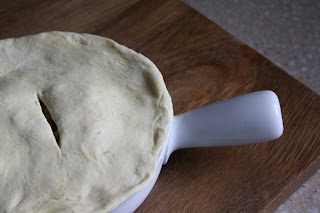Before I start today's blog, I want to apologize to those of you who subscribe to receive email updates. I was told the email didn't get sent out last Friday when I posted. I have no idea what happen, but am hopeful it was just a fluke. My goal is to post something every Friday, so if you don't get an email, feel free to just check out the website. Anyway onto today's entry....
Do you love pesto as much as I do? Pesto is a great way to add some extra flavor to any grain (pasta, rice) or protein (chicken, fish). It is actually quite simple to make as long as you have a blender or food processor. Traditionally, it includes basil, parsley and pine nuts, along with some other staples. A few weeks ago when Zach and I were at the grocery store, I asked him to go get me some pine nuts for a pesto I was going to make. He about had a heart attack when he saw how much the pine nuts cost. Yes, they can be a bit expensive but they are great in a traditional pesto!
Better Bonus Tip: Buy in bulk because it tends to be cheaper and less packaging waste. You can store whatever is left in the freezer to prolong shelf life and prevent them from going rancid.
Traditional Basil and Parsley Pesto
Ingredients:
Basil, handful
Basil, handful
Parsley, handful
Lemon Juice, from one fresh lemon
Lemon Zest, from one fresh lemon
Pine Nuts, handful
Grated or shredded Parmesan cheese, handful
Garlic, 2 cloves
Oil
You will notice the ingredients in this pesto are not exact measurements. This is a hard recipe to really know specifically how much of each item to add - I really recommend tasting as you go and just get it to the flavor, texture and consistency you want depending on what you are using it for.
To zest the lemon and maximize the lemon flavor and essential oils, use a microplane or grater to remove the outer layer, making sure not to remove too much, because the white layer is bitter.
Add all ingredients except the oil into a blender or food processor and pulse the machine. Next, gradually add oil as you continue to pulse the machine. Occasionally stop and manually stir, removing the pesto from the edges of the machine with a rubber spatula. Once you have a nice thick liquid consistency you are done - easy right?
Better Bonus Tip: Substitute other herbs or nuts for different pesto variations.
A few simple ideas for serving pesto:
- Coat a chicken breast in bread crumbs and saute in an oiled pan until crispy. Serve with a drizzle of pesto.
- Wrap shrimp with bacon and cook until no longer pink and bacon is crispy. Serve with a pesto dipping sauce.
- Top a slice of toasted baguette with pesto, a tomato slice, a creamy cheese (fresh mozzarella, brie) and a drizzle of balsamic vinegar.
- Replace a traditional red sauce on pizza with pesto. Top with chicken, shredded cheese and any other toppings that sound good.
Stay tuned, next week I will show you a quick pasta recipe that includes this traditional pesto.
__________________________________________________________________
I have had some questions about garlic after my first post, so I wanted to do a little follow up.
Garlic cloves should be firm and white, without brown or soft spots,. Occasionally, you might find your clove has a green sprout down middle - that means the clove is aging. The taste can be bitter, so you should dispose of that clove and try another.
A garlic bulb can last a long time, few weeks up to a few months, if stored correctly - in an open, cool, dry space. It is hard to say exactly how long it will last, because you don’t know how long it has been at the store. It is not recommended to store garlic in the refrigerator or freezer.
A garlic bulb can last a long time, few weeks up to a few months, if stored correctly - in an open, cool, dry space. It is hard to say exactly how long it will last, because you don’t know how long it has been at the store. It is not recommended to store garlic in the refrigerator or freezer.
Hope that helps!
~Ashley





























